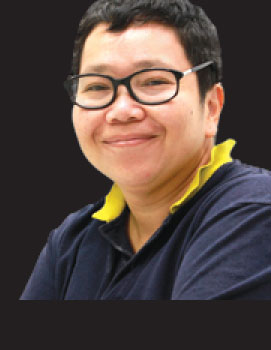
An image can say more than a thousand words. Some can seize us with their haunting memory. Thinking of the bloody crackdown that took place at Tiananmen Square in Beijing 27 years ago conjures the image of the "tank man", an unknown individual -- clad in white shirt, with a shopping bag in his hand -- standing his ground defiantly against tanks on Chang'an Avenue.
Two years ago, in the wake of 25th anniversary of the Tiananmen incident, Western media tried to find the identity of the guy in the photo. It had been reported he just walked out from nowhere. He did an unbelievable thing by climbing up on the tank, knocking on the lid, whispering something to soldiers and then climbing down. After that, he stood opposite the tank, waving back and making a signal as if he wanted the military tank to be moved other way.
The image was shot on the morning of June 5, 1989 when the military violently staged a crackdown on protesters. No one knows where he is now. There have been many theories about his fate. The guy might have been arrested by Chinese authorities, or he just walked away. The allure of the tank man is mysterious because he has never revealed his identity. I bet his image will remain iconic for the fight against authoritarianism for years to come.
In Thailand, an image from Oct 6, 1976 also says more than a thousand words. "The chair" photo taken by Neal Ulevich, an Associated Press photographer is macabre.

Anchalee Kongrut writes about the environment in the Life section, Bangkok Post.
It registered an act of dehumanisation in our memory. The young man was hanged amid a cheering crowd while an enraged man was about to hit the dangling body with a folding chair.
Forty years later, the real identity of the hanged man has never officially been confirmed. It is believed that he was among five people hanged at Sanam Luang, after being lynched by angry mobs. The image reminds us of deeply-rooted and pervasive ultra-nationalism.
One cannot understand it without understanding the fear of the rise of communism in the 1960s and 1970s that threatened national security and overcame moral conscience. Indeed, the October crackdown was one of the atrocities that took place in Thailand's war against communism. The country then was a major ally of the US, providing a military base for the US to fight its war against communism in Indochina. Indeed, atrocious things occurred.
I was nine that year. I was part of the generation taught to sing (and clap our hands and laugh) at the propaganda song Nak Pan Din denouncing non-patriotic Thais. I still remember feeling chills down my spine when seeing images of people hanged on trees in newspapers.
Was it Thailand? Who was the man? Where is his family? Why was he there? What do others feel and why are they cheering? What do we know? In the wake of the 40th anniversary, "the chair" is reused to remind us of the atrocity. Interestingly enough, a friend of mine, a student activist from Thammasat University raised the issue on her Facebook page about the exploitation of "the chair". "How long will the organiser keep using this gory image? It harbours exploitation! Can we use another image to connote this event?"
I found her comment interesting. People question why society keeps on dwelling on this tragic event, and it is better for us to move on. It has been proved that, 40 years on, the country has not moved on, but moved back, if not moved around.
Oh... we've changed a bit: from being an appeaser to the US in the war against communism to Beijing kow-towing (I believe we can do both depending on when and where the tide turns in our favour or our politicians' favour). The military, left on the sidelines decades ago, returned to favour as disillusioned citizens were desperate enough to see them as a knight in shining armour.
Personally, the iconic chair photo is not my favourite one, even though it helps us remember the brutal event. Dwelling in the past is not wasteful. Elie Wiesel, a survivor of the Holocaust and a Nobel Peace Prize laureate said about the need to keep a memory alive: "Those who kept silent yesterday will remain silent tomorrow."
The most important thing is how we remember the October event. For me, I feel sad seeing the images of people marching along Ratchadamnoen Road, protesting against the authoritarian regime. Will our current divisive society return to the same spirit of solidarity? Will there be an event that can unite people? The answer might be sad and grim -- like being hit by the folding chair!

